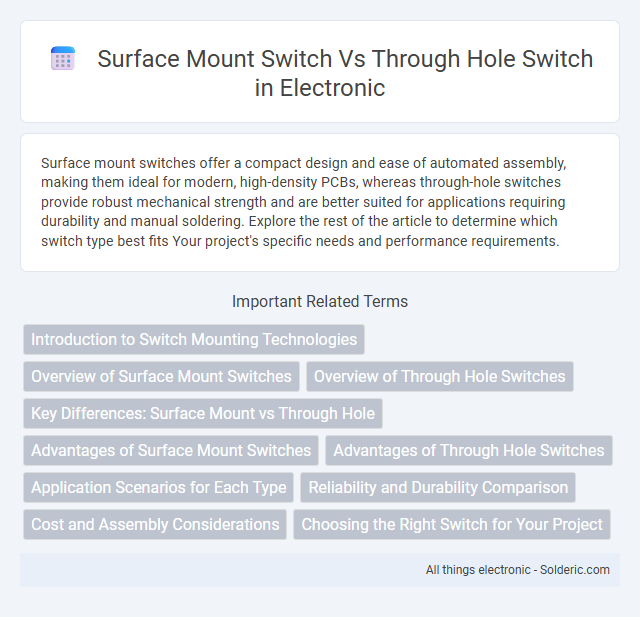Surface mount switches offer a compact design and ease of automated assembly, making them ideal for modern, high-density PCBs, whereas through-hole switches provide robust mechanical strength and are better suited for applications requiring durability and manual soldering. Explore the rest of the article to determine which switch type best fits Your project's specific needs and performance requirements.
Comparison Table
| Feature | Surface Mount Switch | Through Hole Switch |
|---|---|---|
| Mounting Type | Mounted directly on PCB surface pads | Leads inserted through PCB holes and soldered |
| Size | Compact, suitable for high-density PCBs | Larger, requires more board space |
| Assembly | Compatible with automated pick-and-place | Often requires manual or wave soldering |
| Mechanical Strength | Lower mechanical strength on board | Stronger mechanical retention due to leads |
| Electrical Performance | Suitable for high-frequency circuits | More robust for mechanical stress applications |
| Repair & Prototyping | Harder to manually replace or rework | Easier manual soldering and replacement |
| Cost | Typically lower cost in mass production | Higher cost due to assembly labor |
Introduction to Switch Mounting Technologies
Surface mount switches are designed for automated assembly processes, offering compact size and enhanced performance on high-density printed circuit boards (PCBs). Through hole switches, featuring longer leads inserted into drilled holes, provide stronger mechanical bonds ideal for applications requiring durability and frequent manual operation. Selecting the appropriate mounting technology depends on factors such as assembly method, space constraints, and mechanical stress tolerance in electronic device design.
Overview of Surface Mount Switches
Surface mount switches are designed for automated assembly on printed circuit boards (PCBs) where components are soldered directly onto the surface, offering a compact and low-profile solution ideal for modern electronics. These switches provide improved electrical performance and reduced parasitic effects compared to through hole switches due to shorter lead lengths and better mechanical stability. Your choice of surface mount switch enhances manufacturing efficiency and supports high-density circuit designs common in smartphones, laptops, and other portable devices.
Overview of Through Hole Switches
Through hole switches feature leads that pass through the PCB, providing strong mechanical bonds ideal for high-stress applications and robust durability. These switches are favored in prototype development and environments requiring reliable physical connections due to their ease of soldering and replacement. Their larger size compared to surface mount switches often limits their application in compact, high-density circuit designs but enhances their stability and longevity.
Key Differences: Surface Mount vs Through Hole
Surface mount switches are designed for compact PCB layouts with lower profile and automated assembly, while through hole switches feature longer leads for superior mechanical strength and easier manual soldering. Surface mount technology (SMT) enables higher component density and faster production, whereas through hole mounting provides enhanced durability, ideal for high-stress environments. Your choice depends on the specific application requirements, including space constraints and mechanical reliability.
Advantages of Surface Mount Switches
Surface mount switches offer superior placement accuracy and higher component density on printed circuit boards (PCBs), enabling more compact and lightweight electronic designs. Their automated soldering process enhances manufacturing efficiency and reduces production costs compared to through hole switches. Moreover, surface mount switches provide better electrical performance at high frequencies, making them ideal for modern high-speed electronic applications.
Advantages of Through Hole Switches
Through hole switches provide superior mechanical strength due to their leads being inserted through the PCB, enhancing durability in high-stress environments. They offer robust electrical connections and better performance in applications requiring higher current or voltage ratings. These switches are ideal for prototyping and manual assembly, as their larger size simplifies handling and soldering.
Application Scenarios for Each Type
Surface mount switches are ideal for compact electronic devices such as smartphones, tablets, and wearable technology where space-saving and automated assembly are critical. Through hole switches are preferred in applications requiring high mechanical strength and durability, including industrial controls, automotive systems, and heavy machinery due to their robust mounting on printed circuit boards. Each type optimizes performance based on specific mechanical and spatial demands within their respective electronic environments.
Reliability and Durability Comparison
Surface mount switches typically offer higher reliability for automated assembly processes due to their smaller size and consistent solder joint quality, reducing the risk of mechanical failure over time. Through hole switches, while bulkier, provide superior durability in high-stress environments thanks to their robust leads that offer better mechanical support on the PCB. Your choice depends on whether your application prioritizes compact design and production efficiency or enhanced mechanical strength and long-term durability.
Cost and Assembly Considerations
Surface mount switches generally offer lower overall assembly costs due to automated placement and soldering processes, reducing labor and production time. Through hole switches require manual or wave soldering, increasing assembly complexity and cost, especially for high-volume production. Your choice impacts cost-efficiency, with surface mount switches favored for compact, high-density designs and through hole for robust mechanical connections in low-volume or prototype runs.
Choosing the Right Switch for Your Project
Choosing the right switch for your project depends on the design requirements and manufacturing process. Surface mount switches offer compact size and suitability for automated assembly on printed circuit boards (PCBs), making them ideal for high-density electronic devices. Through hole switches provide stronger mechanical connections and easier manual soldering, preferred for prototypes or applications needing durability under physical stress.
Surface mount switch vs Through hole switch Infographic

 solderic.com
solderic.com